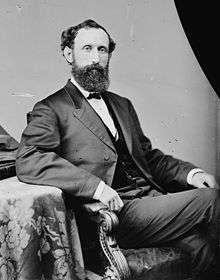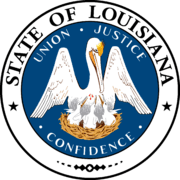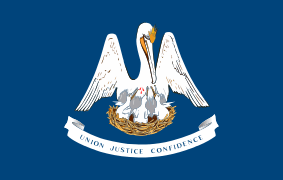William Pitt Kellogg
| William Pitt Kellogg | |
|---|---|
 | |
| United States Senator from Louisiana | |
|
In office March 4, 1877 – March 4, 1883 | |
| Preceded by | Joseph R. West |
| Succeeded by | Randall L. Gibson |
|
In office July 9, 1868 – November 1, 1872 | |
| Preceded by | John Slidell |
| Succeeded by | James B. Eustis |
| Member of the U.S. House of Representatives from Louisiana's 3rd district | |
|
In office March 4, 1883 – March 3, 1885 | |
| Preceded by | Chester Bidwell Darrall |
| Succeeded by | Edward James Gay |
| 26th Governor of Louisiana | |
|
In office May 22, 1873 – January 8, 1877 | |
| Lieutenant | Caesar Antoine |
| Preceded by | John McEnery |
| Succeeded by | Stephen B. Packard |
| Personal details | |
| Born |
December 8, 1830 Orwell, Vermont |
| Died |
August 10, 1918 (aged 87) Washington, D.C. |
| Political party | Republican |
William Pitt Kellogg (December 8, 1830 – August 10, 1918) was an American lawyer and Republican Party politician who served as a United States Senator from 1868 to 1872 and from 1877 to 1883 and as the Governor of Louisiana from 1873 to 1877 during the Reconstruction Era. He was one of the most important politicians in Louisiana during and immediately after Reconstruction and was notable for being elected after most other Republican officials had been defeated when white Democrats regained control of state politics. He is also notable as one of few incumbent Senators to be elected to the House of Representatives, where he served from 1883 to 1885. He was the last elected Republican Governor of Louisiana until Dave Treen in 1980.
Early life and education
Kellogg was born in Orwell in Addison County in western Vermont near the New York boundary, where he spent his childhood.[1] After completing his education in the common schools, he moved to Peoria, Illinois, at the age of eighteen and was a school teacher for several years. His fifth cousin William Kellogg lived in the area and served as a member of the United States House of Representatives from 1857 to 1863.[1]
Career
Kellogg became a lawyer, likely "reading law" and studying with practicing lawyers, as was typical for many then. He moved to Canton, Illinois, and started a law practice. There he joined the U.S. Republican Party and eventually came to know Abraham Lincoln, a fellow lawyer. When Lincoln became President in 1861, he appointed Kellogg as Chief Justice of the Supreme Court of the Nebraska Territory. Kellogg moved to Nebraska.[1]
With the outbreak of the American Civil War, Kellogg was granted a leave of absence and he returned to Illinois and joined the 7th Regiment Illinois Volunteer Cavalry. By 1862, he had risen to the rank of Colonel and played an important role at a small battle near Sikeston, Missouri. Kellogg resigned because of ill health on June 1, 1862. He then returned to Nebraska and resumed his work as Chief Justice. After the Civil War, Kellogg was elected as a companion of the Military Order of the Loyal Legion of the United States.
In 1865, at the end of the Civil War, days before his assassination, Lincoln appointed Kellogg as the federal collector of customs of the port of New Orleans. This launched Kellogg's 20-year political career in Louisiana, notable as he was one of the first carpetbaggers.[1] He remained Collector of New Orleans until 1868, when he was elected to the United States Senate. That year, "reconstructed" Louisiana was readmitted to the federal Union.
In 1872, Kellogg ran on the Republican ticket and was elected Governor. He resigned from the Senate to take office. In the election, John McEnery, a Democrat, ran against Kellogg. The sitting Governor Henry Clay Warmoth, although a Republican, opposed the Republican Party faction that was loyal to President Ulysses S. Grant, who was supporting Kellogg. Warmoth supported McEnery.
Former Confederate Assistant Secretary of War John Archibald Campbell was involved in the controversy surrounding Kellogg. He was a member of the “Committee of One Hundred” that went to Washington to persuade President Grant to end his support of what they called the “Kellogg usurpation”. Grant initially refused to meet them but later relented. Campbell stated the case before Grant but was refused.[2]
The results of the election were disputed by the Democrats. The politics of the state was in turmoil for months, as both candidates held inauguration celebrations, certified their local candidate slates and tried to gather political power. Political tensions broke out in violence, including the Colfax Massacre in April 1873. As Governor, Warmoth controlled the State Returning Board, the institution which administered elections. With the election challenged, Warmoth's board named McEnery the winner. A rival board claimed Kellogg to be the victor, although the board had no ballots or returns to count.[3]
Warmoth was impeached for allegedly stealing the election. A black Republican, P. B. S. Pinchback, became Governor for 35 days until Grant seated Kellogg as Governor with Federal protection. McEnery's faction established a "rump legislature" in New Orleans to oppose Kellogg's actions. McEnery urged his supporters to take up arms against Kellogg's fraudulent government. In 1874 the anti-Republican White League sent 5,000 paramilitary men into New Orleans, where in the Battle of Liberty Place, they defeated the 3500-man Metropolitan Police and state militia. They took over the state government offices for a few days but retreated before the arrival of federal troops sent as reinforcements. President Grant had finally sent U.S. troops in response to Kellogg's request for help.[4]
Kellogg's lieutenant governor was Caesar Antoine, an African-American native of New Orleans. He had been a State Senator from Shreveport before running as lieutenant governor. Despite the intense backlash against the Republican Party among white Democrats in the South, Kellogg was elected to the United States Senate in 1876. He served in the Senate until 1883. He did not seek re-election, for his party was too weak in the South to be competitive. He was the chairman of the Senate Committee on Railroads from 1881 to 1883.
Kellogg was elected to the United States House of Representatives in 1882, defeating the incumbent Democrat Chester Bidwell Darrall and served one term from 1883 to 1885. He was defeated for re-election in 1884 by Edward James Gay. He continued to live in Washington, D.C., but retired from political life. He died in Washington and is buried at Arlington National Cemetery in Virginia.
Kellogg was one of the most important politicians in Louisiana during and immediately after Reconstruction. He was able to maintain power for much longer than most Republican elected officials who had come to the area from the North. He is also notable as one of few Senators to be elected to the House of Representatives immediately after leaving the Senate. (Claude Pepper, a 20th-century Florida Democrat, was similarly elected to the House after having served in the Senate but did not begin his long House tenure until 12 years after the end of his Senate service.)
References
- 1 2 3 4 http://freepages.genealogy.rootsweb.ancestry.com/~jkellogg51/ATT/WPK.html
- ↑ The Ouachita Telegraph. "Death of a Great Jurist." March 12, 1889: 1.
- ↑ Ezell, John (1975). The South Since 1865. New York: Macmillan. ISBN 978-0-02-334750-4.
- ↑ State of Louisiana - Biography
External links
- Works by or about William Pitt Kellogg at Internet Archive
- Louisiana Governor (1873-1877 : Kellogg), Louisiana Governor, 1873-1877 (W.P. Kellogg), William Pitt Kellogg, Louisiana, Governor 1873-1877 : Kellogg (1873). Annual Message of His Excellency Governor Wm. Pitt Kellogg, to the General ... Printed at the Republican office. – Google Books full online browsing copy
- State of Louisiana - Biography
- Cemetery Memorial by La-Cemeteries
| United States Senate | ||
|---|---|---|
| Preceded by vacant1 |
U.S. Senator (Class 3) from Louisiana 1868–1872 Served alongside: John S. Harris, Joseph R. West |
Succeeded by vacant2 |
| Preceded by Joseph R. West |
U.S. Senator (Class 2) from Louisiana 1877–1883 Served alongside: James B. Eustis, Benjamin F. Jonas |
Succeeded by Randall L. Gibson |
| Political offices | ||
| Preceded by John McEnery |
Governor of Louisiana 1873–1877 |
Succeeded by Stephen B. Packard |
| United States House of Representatives | ||
| Preceded by Chester Bidwell Darrall |
Member of the U.S. House of Representatives from Louisiana's 3rd congressional district 1883–1885 |
Succeeded by Edward James Gay |
| Notes and references | ||
| 1. Because Louisiana seceded from the Union in 1861, seat was vacant from 1861-1868 when John Slidell withdrew from the Senate. 2. Seat contested until 1876 when James B. Eustis was elected. | ||



